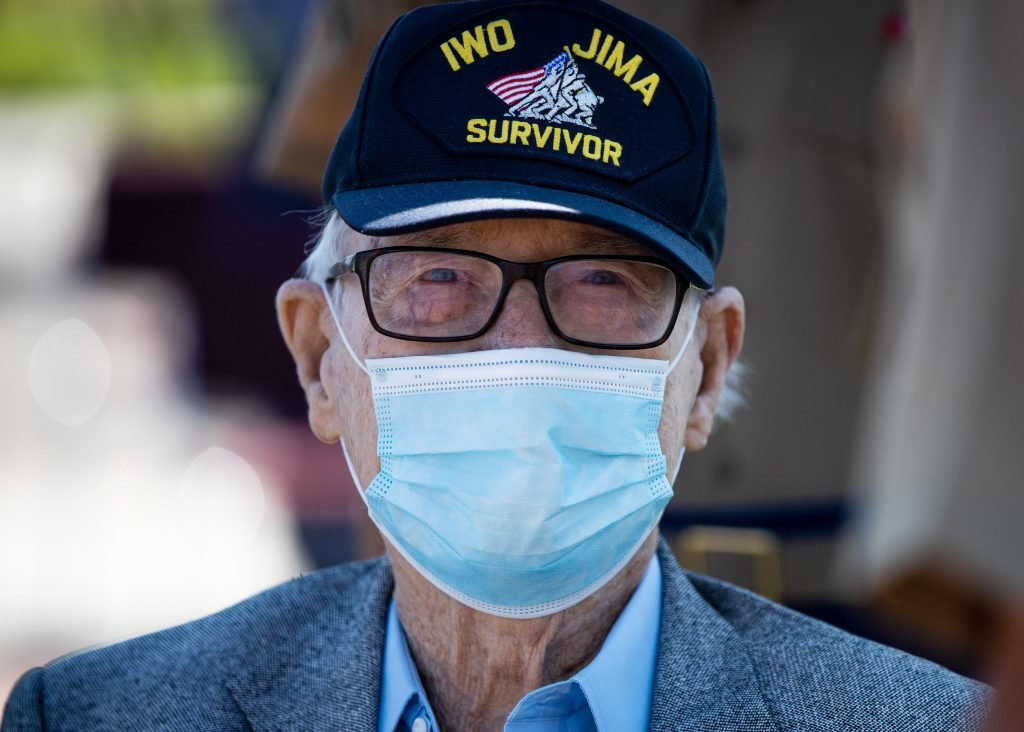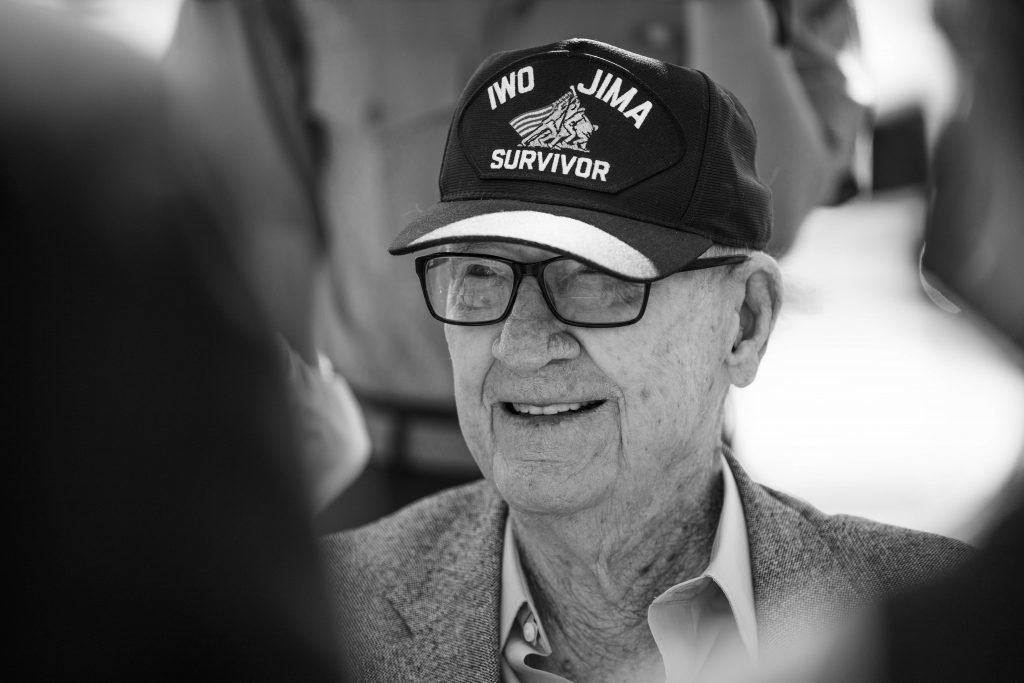Col. Dave Severance, Commander of Marines Who Raised Flag on Iwo Jima, Dies at 102

Marines raise the American flag on top of Mount Suribachi, Iwo Jima. Photo by Joe Rosenthal/Associated Press. Photo courtesy of the National Archives.
Col. Dave Severance, commander of the Marines who famously planted the American flag on Iwo Jima and became an iconic representation of America’s military might, passed away Aug. 2 at his home in La Jolla, California. He was 102 years old.
Severance enlisted in the Marines in 1938 and attended recruit training in San Diego. He volunteered for and completed airborne training, and in 1942, the young, college-educated sergeant was commissioned a second lieutenant.
In 1943, Lt. Severance deployed to the Pacific theater with the Paramarines and saw combat for the first time in the jungles of Bougainville Island. During the battle for Bougainville, Severance proved himself in combat, leading his cutoff platoon out of a Japanese ambush with minimal casualties.
He never made a combat jump before the Marine paratrooper units were disbanded in 1944, but in April of that year, Severance was promoted to captain and given command of Company E, 2nd Battalion, 28th Marine Regiment.

On Feb. 19, 1945, Severance and the men of Company E landed on the black sand beaches of Iwo Jima, having no idea the mark they would leave in the hearts and minds of future generations of Americans.
Four days later, at 10:20 a.m., one of Severance’s platoons reached the summit of Mount Suribachi and raised a small American flag.
“All the ships at sea started their sirens going, and troops were yelling and cheering,” Severance told San Diego’s NBC 7 during a 2015 interview. “You definitely could see that it is an American flag.”
Gen. Holland M. “Howlin’ Mad” Smith and Secretary of the Navy James Forrestal landed on the beach shortly after the first flag went up, and Forrestal asked to have the flag as a memento.
“My battalion commander got that word, and he was heard to say, ‘Hell no! He can’t have our flag! We put it up there, and we’re going to keep it,’” Severance said in a mini-documentary for the National WWII Museum.

Severance’s commander sent a lieutenant down to the beach to get another flag, and the lieutenant came back with the larger, second flag the Marines raised that day. The small task that turned out to be an incredibly significant undertaking fell to a group of Marines who had been chosen to deliver batteries and string wire to the summit.
At the top of the mountain, the Marines constructed a larger flagpole with an additional piece of pipe, tied the large flag to it, and wrote themselves into the history books.
When he heard the second flag was going up, The Associated Press photographer Joe Rosenthal took his position at the summit and snapped his famous Pulitzer Prize-winning photograph.
Despite all the attention the raising of the flag received that day, none of the Company E Marines suspected their actions would receive so much recognition in the years to come.

“It really wasn’t a big deal at the time,” Severance told Coffee or Die Magazine’s Ethan E. Rocke in 2002. “It wasn’t until 1949 when The Sands of Iwo Jima came out — I realized the impact that moment and battle had on the nation.”
The Marine Corps War Memorial, inspired by Rosenthal’s picture, was dedicated near Arlington, Virginia, in 1955, on the Marine Corps birthday, further embedding the event in the annals of American history.
Company E fought at Iwo Jima for 36 days, and 80% of Severance’s men were either killed or wounded in action there.
“We didn’t lose any more or less than any of the other units in the battalion,” he said.
Severance was awarded the Silver Star for his actions on Iwo Jima. His award citation tells the story:
When his company was ordered to launch an attack on a heavily defended ridge south of Nishi Village, Captain Severance skillfully directed the assault against this strong enemy position despite stubborn resistance and courageously led his unit in the accomplishment of its mission. Once the objective was gained, he tenaciously held the position which formed a salient in the line. When the enemy made a fanatic effort to dislodge the company with a concentrated barrage of mortar, machine gun and rifle fire, Captain Severance marshaled his men and held the ridge until the friendly units on his flanks were able to advance and regain contact along the entire front.

In 1946, Severance attended flight training and became a Marine aviator. During the Korean War, he flew 69 combat missions and was awarded the Distinguished Flying Cross and four Air Medals.
Severance retired from the Marine Corps in 1968 while serving as assistant director of personnel, headquarters, Marine Corps.
In June 1996, Severance carried the Olympic torch from the Arlington National Cemetery to the steps of the Marine Corps War Memorial.
Neil McDonough portrayed Severance in Flags of Our Fathers, the Clint Eastwood film depicting the epic battle at Iwo Jima.
On his 100th birthday, Severance told NBC 7 his secret to long life: “I look back, and I didn’t die. As a matter of fact I didn’t even get hit. I came close a couple of times. I made it through three wars.”
Severance also said his wife, who died in 2017, had something to do with his long life well lived.
“I had a wife that took care of me day and night,” he told NBC 7.

The COVID-19 pandemic apparently took a toll on Severance, who stopped going outside last summer. He also stopped taking calls when he struggled to get his hearing aids to work. Concerned, Marine veteran Jim Phillips told Coffee or Die he drove to see his friend in June of 2020.
“I think I’ll have a martini, would you like one?” Phillips recalled Severance asking toward the end of the visit. Phillips declined the offer.
Phillips often found himself saying “Wow! I can’t believe I know Col. Severance!” But on that day he was concerned with driving home safely.
“I completely regret not staying for that drink. That was the last time I saw or heard from him,” Phillips told Coffee or Die.
Severance sometimes wondered why people were in awe when they discovered his link to that unforgettable moment on Mount Suribachi.
A letter the commandant of the Marine Corps sent Severance in 2019 offered a simple explanation. “You played a crucial role in shaping the warrior ethos of our Corps,” it read.

That is undoubtedly true, and it echoes what a young Marine noncommissioned officer said about Severance when he visited the Marine Corps Recruit Depot San Diego in 2002.
“The man made history,” said then-Cpl. Michael Musick, administrative clerk, Headquarters Company. “Marines in Japan take tours of Iwo Jima and take sand from the island as a souvenir. We put up statues on our desks and pictures in our offices, commemorating our heroes. He is one of those heroes.”
Severance is survived by two daughters, two sons, and several grandchildren and great-grandchildren.
Semper Fi, Col. Severance.
Read Next: 4 Lesser-Known Stories From the Battle of Iwo Jima

Mac Caltrider is a senior staff writer for Coffee or Die Magazine. He served in the US Marine Corps and is a former police officer. Caltrider earned his bachelor’s degree in history and now reads anything he can get his hands on. He is also the creator of Pipes & Pages, a site intended to increase readership among enlisted troops. Caltrider spends most of his time reading, writing, and waging a one-man war against premature hair loss.
BRCC and Bad Moon Print Press team up for an exclusive, limited-edition T-shirt design!
BRCC partners with Team Room Design for an exclusive T-shirt release!
Thirty Seconds Out has partnered with BRCC for an exclusive shirt design invoking the God of Winter.
Lucas O'Hara of Grizzly Forge has teamed up with BRCC for a badass, exclusive Shirt Club T-shirt design featuring his most popular knife and tiomahawk.
Coffee or Die sits down with one of the graphic designers behind Black Rifle Coffee's signature look and vibe.
Biden will award the Medal of Honor to a Vietnam War Army helicopter pilot who risked his life to save a reconnaissance team from almost certain death.
Ever wonder how much Jack Mandaville would f*ck sh*t up if he went back in time? The American Revolution didn't even see him coming.
A nearly 200-year-old West Point time capsule that at first appeared to yield little more than dust contains hidden treasure, the US Military Academy said.












